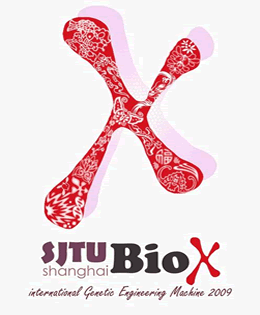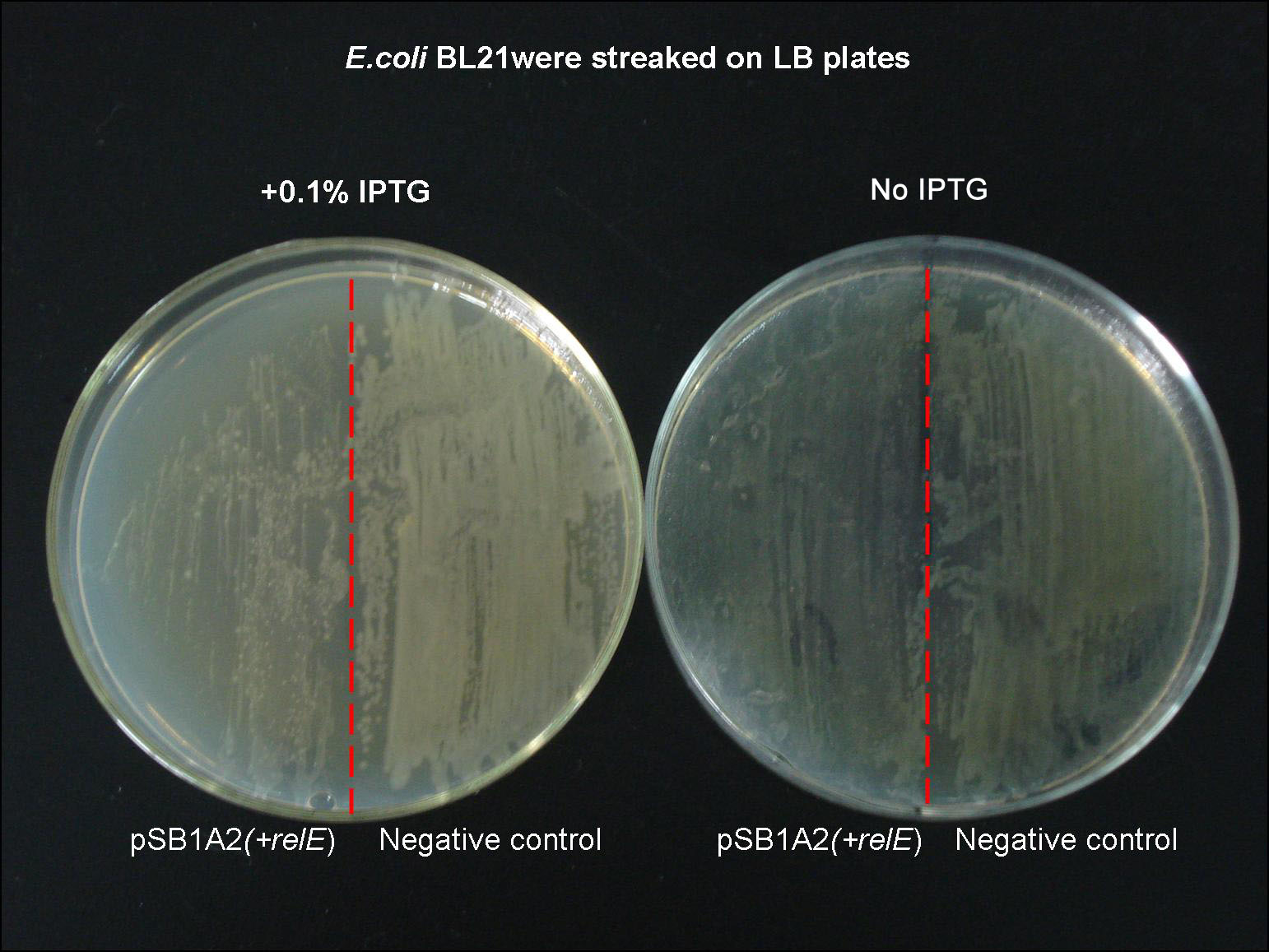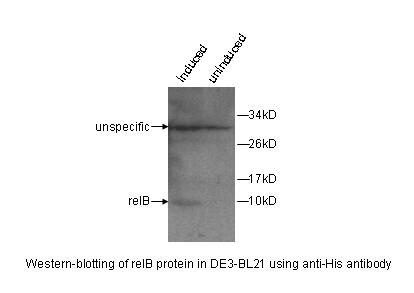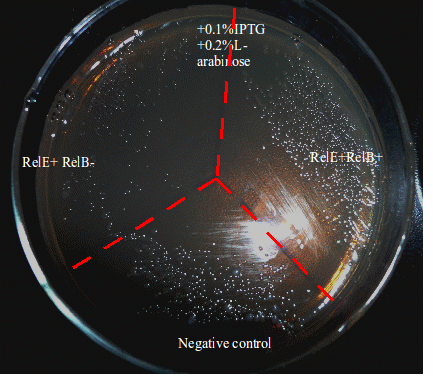Team:SJTU-BioX-Shanghai/Results
From 2009.igem.org
Pnstontale (Talk | contribs) m |
Pnstontale (Talk | contribs) |
||
| Line 3: | Line 3: | ||
=Results overview= | =Results overview= | ||
| - | |||
| - | |||
| - | |||
| - | |||
| - | |||
| - | + | <center><font size=5>'''Detection of bacterial growth activity'''</font></center> | |
| - | We | + | |
| + | As our genetic circuit is complicated in vector designing and logical understanding, involing various influential factors such as RelE-toxin, RelB-antitoxin, Lon protease and tmRNA(ssrA) gene. All the factors interact with each other in a specific method. Among them, TA system (toxin-antitoxin system)works as a vital and esscential part. Therefore, we tested and verified the function of TA system. | ||
| + | |||
| + | ==Part I: Construction of RelE-Toxin Generator== | ||
| + | |||
| + | RelE-toxin and RelB-antitoxin are the basic parts in our project, the genes of which are present on the ''Escherichia coli'' chromosome. First of all, we cloned the RelE and RelB gene in ''Escherichia coli str. K-12 substr''. ''DH10B'' through PCR technology. To meet our design, we have made some modifications to their PCR primers : (1)The stop condon of RelE gene is mutated to <font color=red>TAA</font> (2)A 18bp <font color=red>His-tag</font> is linked before the stop codon to facilliate its detection. | ||
| + | |||
| + | |||
| + | '''The primers of RelE and RelB:''' | ||
| + | |||
| + | {| style="border:1px solid; font-size: 12px;" | ||
| + | |sepTA102-RelE-F: ||5’- <font color=blue>CGGAATTCGCGGCCGCTTCTAG</font>ATGGCGTATTTTCTGGATTTTGAC-3’ | ||
| + | |- | ||
| + | |sepTA102-RelE-R: ||5’-<font color=blue>GGACTAGTA</font><font color=red>TTA</font><font color=green>GTGATGATGATGATGATG</font>GAGAATGCGTTTGACCGCCTCGC-3’ | ||
| + | |- | ||
| + | |sepTA102-RelB-F: ||5’-<font color=blue>CCGGAATTCGCGGCCGCTTCTAG</font>ATGGGTAGCATTAACCTGCGTAT-3’ | ||
| + | |- | ||
| + | |sepTA102-RelB-R: ||5’-<font color=blue>GGACTAGTACTCA</font><font color=green>GTGATGATGATGATGATG</font>GAGTTCATCCAGCGTCACAC-3’ | ||
| + | |} | ||
| + | :''The <font color=blue>'''blue sequence'''</font> is biobrick prefix and surfix; <font color=green>'''Green sequence'''</font> is His-tag; <font color=red>'''Red sequence'''</font> is mutated RelE stop codon; '''Black sequence''' is matching nucleotide.'' | ||
| + | |||
| + | Then we added transcription terminator(here we chose BBa_B0015) to RelE and RelB gene, converting them into complete transcriptional unit. We choose pSB1A2 as the vector. After recombinition of RelE and Terminator, a typical Lac Promoter is inserted before RelE-Terminator complex. Eventually, a basic RelE-Toxin Generater turned out.The following picture shows the digestion results of agar electrophoresis. | ||
| + | |||
| + | :'''Fig 1.Construct results of RelE+Double terminator and RelE+Rbs''' | ||
| + | [[Image:Result_Overview_html_e1d1bd4.gif|center]] | ||
| + | *''Lane2: [http://partsregistry.org/wiki/index.php?title=Part:BBa_K185000 BBa_K185000] RelE toxin+Rbs30 311bp '' | ||
| + | *''Lane3: [http://partsregistry.org/wiki/index.php?title=Part:BBa_K185004 BBa_K185004] RelE toxin+Double terminator 443bp '' | ||
| + | |||
| + | |||
| + | ==Part II: Insight into Growth Acticity of RelE Strain== | ||
| + | |||
| + | After identification of reconstruced plasmid, we transfected the plasmid into E.coli BL21 strain. In the E.coli strain containing RelE-toxin gene, after adding 0.1% IPTG onto the LB plate to induce its expression, it grows in a low metabolism rate compared with negative control group. The most obvious evidence is the phenomenon that it can hardly form colonies after induction., meanwhile the negative control group developed a lot of colonies after 20 hours. | ||
| + | |||
| + | :'''Fig 2. expression of relE on growth of ''E.coli ''cells''' | ||
| + | [[Image:Result_Overview_html_4813e17d.jpg|center|thumb|500px|expression of relE on growth of ''E.coli ''cells]] | ||
| + | :''The left plate contains 0.1% IPTG, which is used to induce RelE-toxin protein. Onced RelE is expressed, bacteria can hardly form colonies even after 20 hours’ cultivation. The plate in the right lacks inducer(IPTG), we can still see the RelE+ strain grows a bit slower than negative control group. It can be explained by the basal transcription of the Lac promoter.'' | ||
| + | |||
| + | |||
| + | ==Part III: Recovering Function Test of RelB Antitoxin== | ||
| + | |||
| + | In bacteria chromosome, RelB is located in the same operon with RelE. RelB is also a small protein like RelE, about 10 kD. It forms a heterotetrameric (RelB-RelE)<sub>2</sub> structure when binding with RelE. It is difficult to detect the function of RelB through plate oberservation, since overexpression of RelB-antitoxin has no influence on bacteria growth. We have to put the RelE+RelB- strain and RelE+RelB+ strain togther to verify the recovering function of RelB antitoxin. As mentioned before, a His-tag has been linked at the end of RelB protein. Firstly, we used anti-His antibody to detect whether RelB protein has been expressed. Then we streaked the RelE+RelB+, RelE+RelB- and negative control group on a M9 plate. To induce the promoter, 0.1%IPTG and 0.2% L-arabinose is respectively added onto the M9 plate. | ||
| + | |||
| + | The Western-blotting picture(Figure 3) shows that RelB protein is expressed once induced by L-arabinose, whereas no RelB protein is produced under normal enviroment (with no induction). Figure 4 demonstrates the growth activity of RelE+RelB+. The bacteria expressing both RelE and RelB proliferate like negative control group, while the bacteria expressing RelE can hardly form colonies. The fact we see on the plate illustrates the recovering function of RelB Antitoxin. | ||
| + | |||
| + | :'''Fig 3. Western -blotting results when RelB is induced''' | ||
| + | [[Image:Result_Overview_html_3b058507.png|center]] | ||
| + | :''When L-arabinose is added in the culture, the RelB+ strain is activated, starting to produce RelB proteins(Left ). If no iducer is provided, consequently it turns out no RelB protein.'' | ||
| + | |||
| + | |||
| + | :'''Fig 4. Plate colony oberservation of RelE+RelB+ and RelE+ RelB-''' | ||
| + | [[Image:Result_Overview_html_m2a1a3131.gif|center]] | ||
| + | :''The plate is devided into three regions: RelE+RleB-(only expressing ReE-toxin), RelE+RelB+(expressing both RelE-toxin and RelB-antitoxin), NC group(BL21 containing Amp resistance). The phenotype of RelE+RelB- demonstrates RelE’s inhibition in growth, whereas the E.coli strain expressing both RelE-toxin and RelB-antitoxin restored from inhibition. '' | ||
| + | |||
| + | |||
| + | ==Part IV: RelE Strain Growth Curve== | ||
| - | |||
| - | |||
| - | |||
| - | |||
| - | |||
| - | |||
| - | |||
{{Template:SJTU09_enddiv}} | {{Template:SJTU09_enddiv}} | ||
Revision as of 03:53, 21 October 2009

Project introduction. Inspired by the natural regulator of circadian bioclock exhibited in most eukaryotic organisms, our team has designed an E.coli-based genetic network with the toxin-antitoxin system so that the bacterium oscillates between two states of dormancy and activity (more...)
Contents |
Results overview
As our genetic circuit is complicated in vector designing and logical understanding, involing various influential factors such as RelE-toxin, RelB-antitoxin, Lon protease and tmRNA(ssrA) gene. All the factors interact with each other in a specific method. Among them, TA system (toxin-antitoxin system)works as a vital and esscential part. Therefore, we tested and verified the function of TA system.
Part I: Construction of RelE-Toxin Generator
RelE-toxin and RelB-antitoxin are the basic parts in our project, the genes of which are present on the Escherichia coli chromosome. First of all, we cloned the RelE and RelB gene in Escherichia coli str. K-12 substr. DH10B through PCR technology. To meet our design, we have made some modifications to their PCR primers : (1)The stop condon of RelE gene is mutated to TAA (2)A 18bp His-tag is linked before the stop codon to facilliate its detection.
The primers of RelE and RelB:
| sepTA102-RelE-F: | 5’- CGGAATTCGCGGCCGCTTCTAGATGGCGTATTTTCTGGATTTTGAC-3’ |
| sepTA102-RelE-R: | 5’-GGACTAGTATTAGTGATGATGATGATGATGGAGAATGCGTTTGACCGCCTCGC-3’ |
| sepTA102-RelB-F: | 5’-CCGGAATTCGCGGCCGCTTCTAGATGGGTAGCATTAACCTGCGTAT-3’ |
| sepTA102-RelB-R: | 5’-GGACTAGTACTCAGTGATGATGATGATGATGGAGTTCATCCAGCGTCACAC-3’ |
- The blue sequence is biobrick prefix and surfix; Green sequence is His-tag; Red sequence is mutated RelE stop codon; Black sequence is matching nucleotide.
Then we added transcription terminator(here we chose BBa_B0015) to RelE and RelB gene, converting them into complete transcriptional unit. We choose pSB1A2 as the vector. After recombinition of RelE and Terminator, a typical Lac Promoter is inserted before RelE-Terminator complex. Eventually, a basic RelE-Toxin Generater turned out.The following picture shows the digestion results of agar electrophoresis.
- Fig 1.Construct results of RelE+Double terminator and RelE+Rbs
- Lane2: BBa_K185000 RelE toxin+Rbs30 311bp
- Lane3: BBa_K185004 RelE toxin+Double terminator 443bp
Part II: Insight into Growth Acticity of RelE Strain
After identification of reconstruced plasmid, we transfected the plasmid into E.coli BL21 strain. In the E.coli strain containing RelE-toxin gene, after adding 0.1% IPTG onto the LB plate to induce its expression, it grows in a low metabolism rate compared with negative control group. The most obvious evidence is the phenomenon that it can hardly form colonies after induction., meanwhile the negative control group developed a lot of colonies after 20 hours.
- Fig 2. expression of relE on growth of E.coli cells
- The left plate contains 0.1% IPTG, which is used to induce RelE-toxin protein. Onced RelE is expressed, bacteria can hardly form colonies even after 20 hours’ cultivation. The plate in the right lacks inducer(IPTG), we can still see the RelE+ strain grows a bit slower than negative control group. It can be explained by the basal transcription of the Lac promoter.
Part III: Recovering Function Test of RelB Antitoxin
In bacteria chromosome, RelB is located in the same operon with RelE. RelB is also a small protein like RelE, about 10 kD. It forms a heterotetrameric (RelB-RelE)2 structure when binding with RelE. It is difficult to detect the function of RelB through plate oberservation, since overexpression of RelB-antitoxin has no influence on bacteria growth. We have to put the RelE+RelB- strain and RelE+RelB+ strain togther to verify the recovering function of RelB antitoxin. As mentioned before, a His-tag has been linked at the end of RelB protein. Firstly, we used anti-His antibody to detect whether RelB protein has been expressed. Then we streaked the RelE+RelB+, RelE+RelB- and negative control group on a M9 plate. To induce the promoter, 0.1%IPTG and 0.2% L-arabinose is respectively added onto the M9 plate.
The Western-blotting picture(Figure 3) shows that RelB protein is expressed once induced by L-arabinose, whereas no RelB protein is produced under normal enviroment (with no induction). Figure 4 demonstrates the growth activity of RelE+RelB+. The bacteria expressing both RelE and RelB proliferate like negative control group, while the bacteria expressing RelE can hardly form colonies. The fact we see on the plate illustrates the recovering function of RelB Antitoxin.
- Fig 3. Western -blotting results when RelB is induced
- When L-arabinose is added in the culture, the RelB+ strain is activated, starting to produce RelB proteins(Left ). If no iducer is provided, consequently it turns out no RelB protein.
- Fig 4. Plate colony oberservation of RelE+RelB+ and RelE+ RelB-
- The plate is devided into three regions: RelE+RleB-(only expressing ReE-toxin), RelE+RelB+(expressing both RelE-toxin and RelB-antitoxin), NC group(BL21 containing Amp resistance). The phenotype of RelE+RelB- demonstrates RelE’s inhibition in growth, whereas the E.coli strain expressing both RelE-toxin and RelB-antitoxin restored from inhibition.
Part IV: RelE Strain Growth Curve
 "
"



